If you've got an active sourdough starter, make this delicious, chewy sourdough pizza crust! The timing is flexible, so you can mix up the dough, let it ferment, and bake when you're ready.
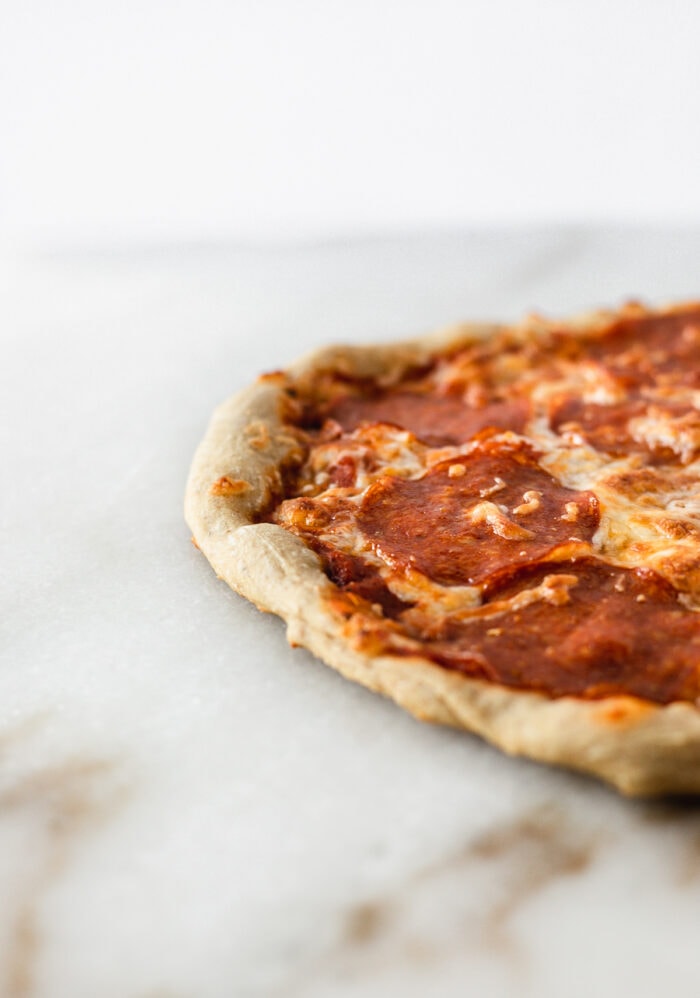
Sourdough baking goes way beyond bread! Sourdough starter and a long fermentation make a delightfully chewy, flavorful pizza crust with air bubbles and a crisp bottom. If you've got an active sourdough starter, whip up this pizza dough and stash some in the freezer for next time you're craving pizza!
Why You'll Love This Sourdough Pizza Crust
With a little planning ahead, this sourdough pizza dough is ready to bake whenever you are. The recipe makes 4 pizza crusts, so you can bake one now and save the rest for later in the refrigerator or freezer. The flavor and texture of the crust benefit from a long fermentation and both whole wheat and bread flours. The chewy, airy crust is the most delicious base for homemade pizza!
How To Make Sourdough Pizza Crust
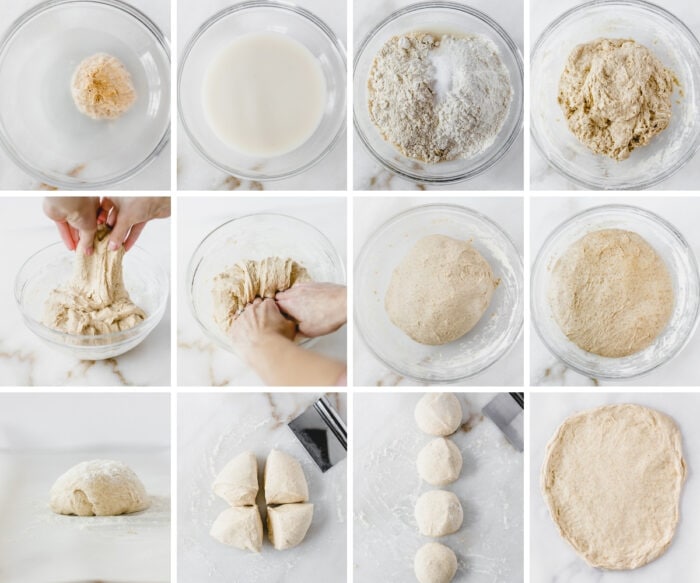
- Mix active sourdough starter and water.
- Add the flours and salt and stir to form a shaggy dough. Cover and let the dough rest for 30 minutes.
- Stretch and fold the dough. Grab an edge of the dough and stretch it upward, then fold it back into the center of the dough. Rotate the bowl and quarter turn and repeat until you've made your way around the bowl (for a total of 4 times). This is one set. Do a set of 'stretch and folds' every 30 minutes for a total of 4 sets.
- After the last set of 'stretch and folds' cover the dough and let it rest at room temperature until roughly doubled in volume, anywhere from 4-10 hours, depending on the temperature of your kitchen.
- Turn the dough onto a lightly floured surface and gently shape into a ball. Divide the dough into 4 pieces and shape each piece into a ball.
- Cover or wrap each piece individually (use a container or plastic wrap) and refrigerate for at least 6 hours, up to 3 days, until you're ready to bake. You can also freeze the dough at this point.
- Once ready to bake, remove the dough from the refrigerator and let it rest at room temperature for an hour.
- Stretch the dough into a circle and place on a piece of parchment, being careful to keep any air bubbles intact.
- Top the dough however you'd like and bake on a preheated pizza stone at 500°F for 9-12 minutes, or until golden and crisp on the edges.
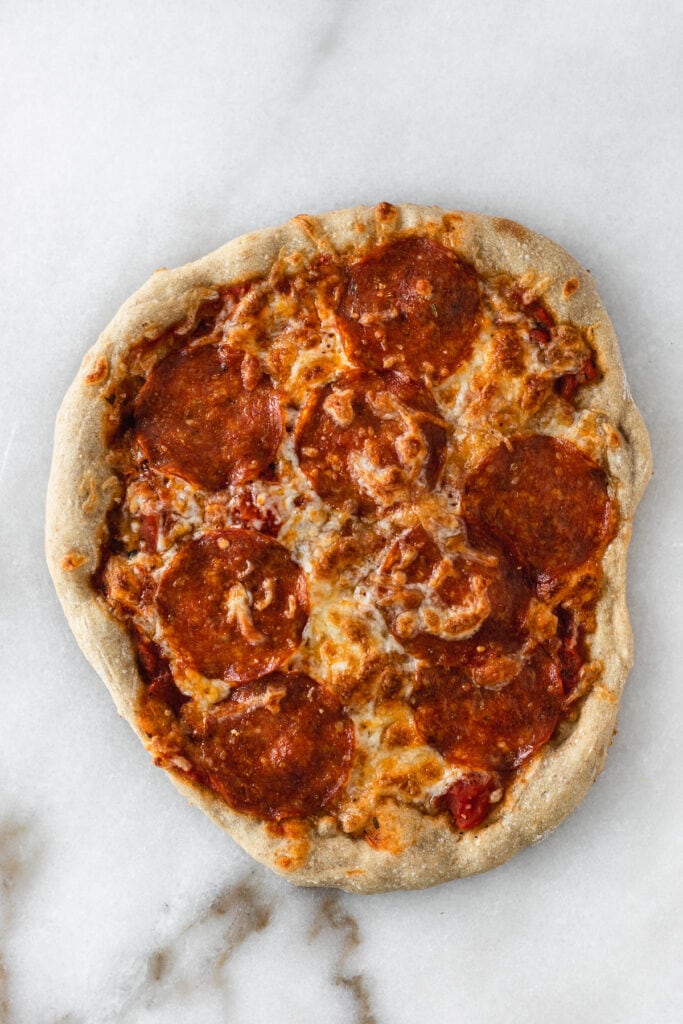
Sample Baking Schedule
This dough has 2 long fermentation periods, so it takes a little pre-thought. The good news is, the refrigerated fermentation is very flexible, so you can leave it up to 3 days before baking! This schedule starts in the morning the day before baking and has the second fermentation overnight, but you can also start in the early evening and let the dough complete bulk fermentation at room temperature overnight.
- 9 am - Mix the dough. Cover and rest.
- 9:30 am - Begin stretch and folds.
- 11 am - Last set of stretch and folds. Cover the dough and begin bulk fermentation (4-10 hours).
- 8 pm - Shape and divide dough. Place in the refrigerator for second fermentation.
- 5 pm second day - Remove dough from refrigerator.
- 6 pm - Stretch dough and bake.
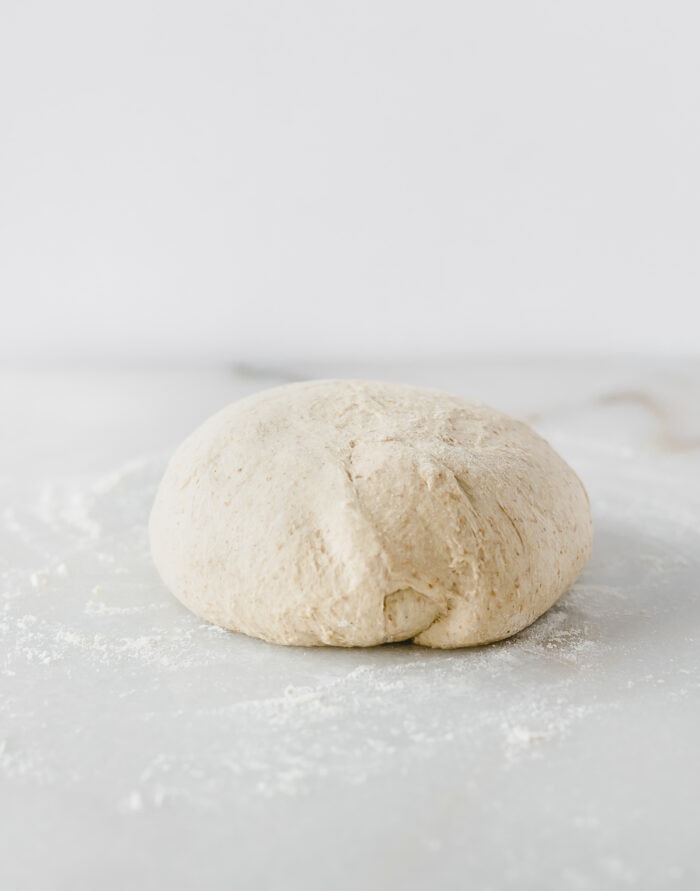
Tips for Perfect Pizza Crust
- Make sure your sourdough starter is bubbly and active.
- The flours are somewhat flexible. If you don't have whole wheat flour, you can use all purpose, but I've found that you do need some bread flour to strengthen the dough so that you can stretch it more easily.
- The 'stretch and folds' don't have to be super accurate in timing. If you forget one, or if you only have time for 3 before doing the bulk fermentation, that's okay!
- Rely on visual cues rather than the clock to determine when the bulk fermentation (the room temperature rest) is done. The dough should look inflated and be roughly doubled in size. You don't want to let it go too long.
- When shaping and stretching the dough, do so gently. You want to keep as many air bubbles in the dough as possible for an airy crust.
- If you don't have a pizza stone, you can bake your pizza on a baking sheet.
Freezing Sourdough Pizza Crust
This dough freezes beautifully! After dividing the dough into individual portions, you can place it in the freezer for later use. Remove it from the freezer and let it thaw and come to room temperature before using it.
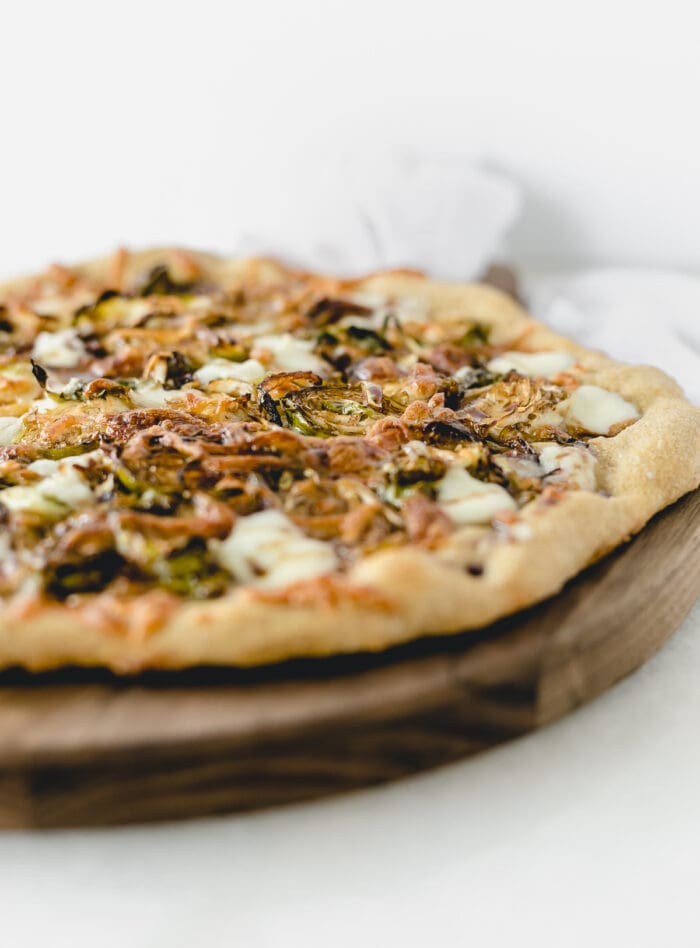
Try These Pizza Recipes!
- Garlic Chicken White Pizza (Pizza Bianca)
- Snap Pea Asparagus Pizza with Arugula and Burrata
- Caramelized Onion Brussels Sprout Pizza
- Blackberry BBQ Chicken Pizza
Did you make this recipe? Please leave a star rating in the comments!
PrintSourdough Pizza Crust
If you've got an active sourdough starter, make this delicious, chewy sourdough pizza crust! The timing is flexible, so you can mix up the dough, let it ferment, and bake when you're ready.
- Prep Time: 10 minutes
- Proofing Time: 17 hours
- Cook Time: 10 minutes
- Total Time: 17 hours 20 minutes
- Yield: 4 pizza crusts 1x
- Category: bread
- Method: fermented
- Cuisine: American
Ingredients
- 100 grams active sourdough starter
- 350 grams room temperature water
- 300 grams whole wheat pastry flour (or all purpose flour)
- 200 grams bread flour
- 10 grams salt
Instructions
- In a large bowl, mix the starter and water until combined.
- Stir in the flours and salt until a shaggy dough forms. Cover the dough and let it rest for 30 minutes.
- Perform 'stretch and folds' by grabbing one edge of the dough in the bowl and stretching it upward, then folding it back into the center of the dough. Give the bowl a quarter turn and repeat until you've stretched the edges all the way around the bowl (four times). This is on set. Do a set of 'stretch and folds' every 30 minutes for a total of 4 sets.
- Cover the dough and let it rise at room temperature until doubled in volume (anywhere from 4 to 10 hours). The time will depend on the strength of your starter and the temperature of your kitchen.
- Once dough has risen, turn the dough out onto a lightly floured surface and shape it into a ball. Divide the ball into four equal pieces of dough and shape each into a small ball.
- Cover each ball individually (in containers or wrapped in plastic) and store in the refrigerator for at least 6 hours, or up to 3 days.
- Once you are ready to bake, take the dough out of the refrigerator and let it stand 1 hour.
- Stretch the dough into a thin circle, trying to keep any bubbles intact, onto a piece of parchment.
- Top the dough with whatever toppings you'd like and bake at 500°F on a preheated pizza stone (if you have one) or a baking sheet until golden and crispy.
Notes
- Make sure your sourdough starter is bubbly and active.
- The flours are somewhat flexible. If you don't have whole wheat flour, you can use all purpose, but I've found that you do need some bread flour to strengthen the dough so that you can stretch it more easily.
- The 'stretch and folds' don't have to be super accurate in timing. If you forget one, or if you only have time for 3 before doing the bulk fermentation, that's okay!
- Rely on visual cues rather than the clock to determine when the bulk fermentation (the room temperature rest) is done. The dough should look inflated and be roughly doubled in size. You don't want to let it go too long.
- When shaping and stretching the dough, do so gently. You want to keep as many air bubbles in the dough as possible for an airy crust.
- If you don't have a pizza stone, you can bake your pizza on a baking sheet.
- This dough freezes beautifully! After dividing the dough into individual portions, you can place it in the freezer for later use. Remove it from the freezer and let it thaw and come to room temperature before using it.
Keywords: sourdough pizza crust, whole wheat sourdough pizza dough, sourdough pizza dough


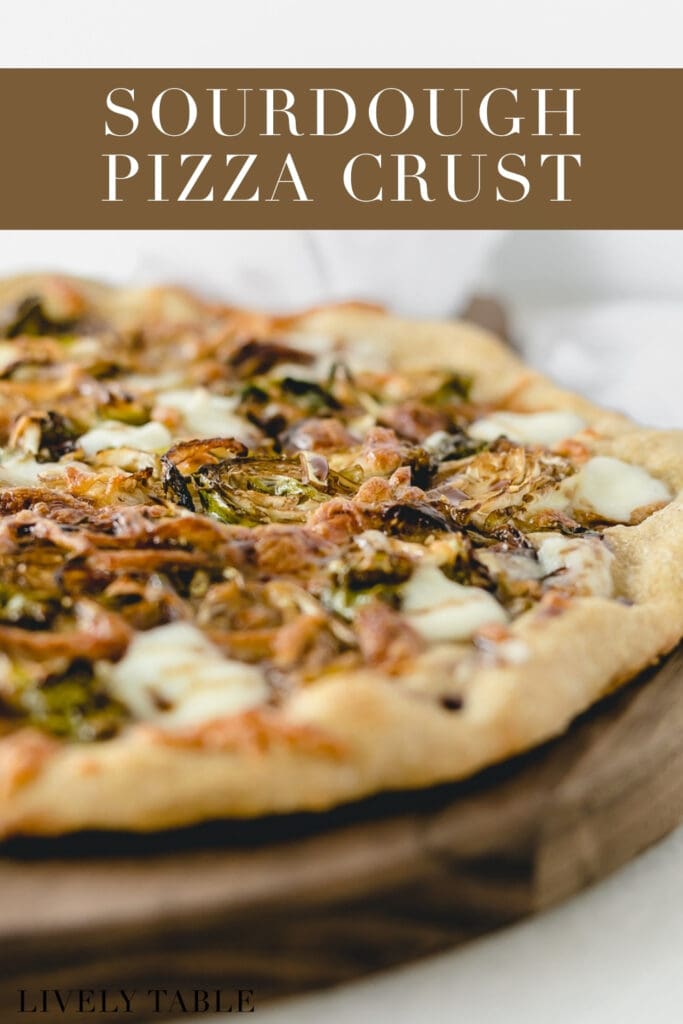

Leave a Reply